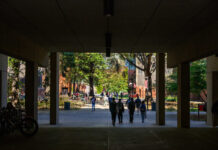From March 7 to 9, the students, along with two advisors, visited Birmingham, Selma and Montgomery, stopping at many of the important sites of the modern civil rights movement. It was in Selma on March 7, 1965, that hundreds of peaceful activists marching in support of voting rights were beaten and tear-gassed.
“Seeing the locations of the struggle for civil rights, it makes it real,” said community member Arthur Clemons. “I knew about what happened, but now I’ve seen where and that means a lot to me.”
The trip was part of the five-year Project Progress Initiative, which focuses on the activities and aftermath of the “heroic period” of the American civil rights movement from the Montgomery bus boycotts of 1963 through the assassination of Dr. Martin Luther King Jr. in 1968.
It also supported the goal of the Rustin Community, which is to study both LGBT identity and social justice and to be inspired by the life of gay civil rights leader Bayard Rustin. Rustin was the organizer of the 1963 March on Washington and a key advisor to King.
Students prepared for the trip by studying important moments in the civil rights movement and learning how Rustin played a role. They also learned how the movement paved the way for other oppressed communities, like LGBT people, to work for change.
The group walked across the Edmund Pettus Bridge, site of “Bloody Sunday,” toured museums and exhibits, and walked the last half-mile of the 1965 voting rights march.
“I cannot imagine the strength of will that it took for people to stand up for what they knew was right in the face of death and violence,” said community member DeVictor McElroy. “I don’t know if I could have done it, but I am so thankful that they did.”


























